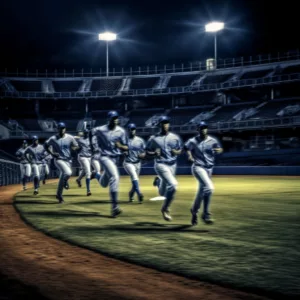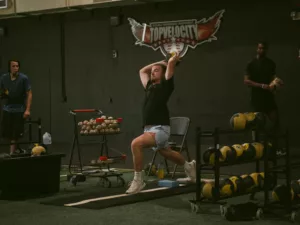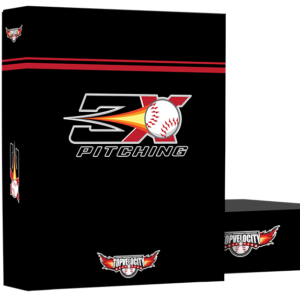Running poles have long been a topic of debate in baseball, particularly among pitchers. The inclusion of running poles in a pitcher's training plan has prompted concerns about its efficacy and effects on pitching performance. In this detailed post, we will look at the science behind running poles for pitchers in baseball. We will look at classic pitcher training methods, explain why a pitcher's arm may feel better after running the day after pitching, debunk the fallacy about lactic acid and muscular soreness, and offer tips on avoiding unusual throwing arm stiffness. In addition, we will explore baseball pitchers' energy requirements, review data on heart rate intensity during pitching and conditioning, and offer a practical example of a 5-day starting pitcher's conditioning regimen.
Running Poles in Baseball Science: Low Intensity vs. High Intensity
 The Drawbacks of Low-Intensity Running Poles in Baseball: Scientific Evidence
The Drawbacks of Low-Intensity Running Poles in Baseball: Scientific Evidence
Potteiger et al. (4) conducted study that gives light on the potential harmful impacts of depending primarily on low-intensity pole running for pitcher training. Their research looked at how different training programs affected pitchers' throwing velocity and anaerobic power. Pitchers who took part in an aerobic training program had no increases in throwing velocity or anaerobic power. Those in the weight/sprint training group, on the other hand, showed a significant improvement in throwing velocity (3.0%) and anaerobic power (4.2%). This emphasizes the need of including anaerobic exercises in the training regimen, such as short sprints at high intensities.
Rhea et al. (6) studied the effects of aerobic vs. anaerobic fitness across an 18-week college baseball season, lending support to this hypothesis. The only difference between the two groups was that they both did resistance and plyometric exercise. One group concentrated on moderate- to high-intensity cardiovascular endurance training, whereas the other focused on speed/speed endurance training, which included 3-4 days per week of repeated maximal sprints of 15-60 meters. The results showed that the speed/speed endurance training group enhanced lower body power (vertical jump) by 15.3%, but the aerobically trained group suffered a reduction (-2.6%). Rhea et al. (6) concluded that aerobic training may not be appropriate throughout the baseball season, emphasizing the need for anaerobic training due to the sport's reliance on speed and power.
According to this study, pitchers might consider adopting anaerobic interval conditioning routines to improve their effectiveness. Experts such as Coleman (1), Kritz et al. (2), Odgers and Gambetta (3), Potteiger et al. (4), Potteiger and Wilson (5), and Szymanski (7) have developed various training programs tailored for different pitcher roles, providing valuable insights into optimizing training strategies for baseball success.
The Lactic Acid Myth Busted
 Why Does a Pitcher's Arm Feel Better After Running Poles in Baseball?
Why Does a Pitcher's Arm Feel Better After Running Poles in Baseball?
The feeling of better arm mobility and comfort after running or conducting modest exercise the day after pitching is a common phenomenon among pitchers. This improvement is frequently linked to improved blood flow as a result of jogging. Blood flow helps transport nutrients and oxygen to the muscles, which aids in healing. However, contrary to popular belief, this effect is not caused by "flushing out" lactic acid from the arm.
Lactic Acid and Muscle Soreness: What You Need to Know
Contrary to popular assumption, lactic acid is not the primary cause of pitchers' post-pitch muscular discomfort. According to research, lactic acid levels do not rise sufficiently during pitching to have a major impact on muscle function. It is a common misperception that lactic acid causes persistent muscular discomfort. Lactic acid levels normally recover to baseline 40-60 minutes after high-intensity exercise, and their contribution to muscle soreness is negligible.
Factors Contributing to Throwing Arm Soreness Preventing Unusual Throwing Arm Soreness
Unusual throwing arm pain can be caused by a variety of circumstances, including poor mechanics, overexertion, a lack of suitable rest, and insufficient warm-up exercises. While traditional conditioning regimens can help prepare a pitcher's body for the rigors of the game, proper recovery, and rest intervals are also necessary to avoid throwing arm pain.
Energy Needs and Heart Rate Intensity When Running Poles in Baseball
 Understanding Baseball Pitchers' Energy Needs
Understanding Baseball Pitchers' Energy Needs
Baseball throwing is a physically demanding sport that needs a lot of energy. Pitching's explosive motions, including the wind-up and release, exert demands on the body's numerous energy systems. Pitchers must maintain optimum diet and hydration in order to satisfy these energy demands and maintain peak performance.
Evaluating Pitching and Conditioning Heart Rate Intensity
The intensity of heart rates during pitching and conditioning activities has been studied. Monitoring heart rate intensity allows pitchers to customize their training routines to the game's demands. Conditioning programs that are effective focus on boosting cardiovascular fitness while taking into account the specific energy demands of pitching.
A Real-World Example: A 5-Day Starting Pitcher's Conditioning Program
Here's an example of a 5-day starting pitcher training regimen to provide you with a practical perspective on pitcher conditioning:
Day 1: Active Recuperation
- Dynamic stretching and light jogging
- Maintain flexibility and blood flow as much as possible.
Day 2: Strength and Conditioning
- Resistance training that focuses on main muscle groups
- Include exercises that improve core stability and lower-body strength.
Day 3: Pitching Techniques and Mechanics
- Concentrate on improving pitching mechanics and control.
- Use video analysis to pinpoint areas for improvement.
Day 4: Interval Training
- HIIT (high-intensity interval training) to increase cardiovascular endurance
- Alternate between vigorous spurts of activity and brief periods of rest.
Day 5: Rest and Recovery
- Foam rolling and static stretching are examples of active recovery treatments.
- Rest is important in order for the body to recover before the next throwing session.
The 3X Pitching Velocity Program's Advantage to Running Poles in Baseball
The 3X Pitching Velocity program stands out as a superior method for pitching performance enhancement that is based on science and innovation. Brent Pourciau's ground-breaking program provides a comprehensive methodology that goes beyond typical training methods. Here are some of the reasons why the 3X Pitching Velocity program is a superior way to develop pitching excellence:
 Scientific Basis: The 3X Pitching Velocity program is founded on a strong foundation of sports science and biomechanics. The curriculum incorporates evidence-based methods, drawing on Brent Pourciau's expertise as a retired professional pitcher and his significant studies in kinesiology and sports science. The program enhances efficiency, power creation, and injury prevention by studying the intricate mechanics of the pitching motion.
Scientific Basis: The 3X Pitching Velocity program is founded on a strong foundation of sports science and biomechanics. The curriculum incorporates evidence-based methods, drawing on Brent Pourciau's expertise as a retired professional pitcher and his significant studies in kinesiology and sports science. The program enhances efficiency, power creation, and injury prevention by studying the intricate mechanics of the pitching motion.- New Techniques: This curriculum teaches new techniques that question conventional conventions. Pourciau's experience overcoming a career-ending rotator cuff tear illustrates his commitment to pushing the limits of what is possible. The 3X Pitching Velocity program employs novel training approaches, using the power of velocity-enhancing motions and exercises that enhance agility, explosiveness, and dynamic strength.
- Personalized Approach: When it comes to pitching development, one size does not suit all. The 3X Pitching Velocity program values each pitcher's unique body mechanics, strengths, and areas for improvement. The program tailors training procedures based on tailored assessments to target specific shortcomings and capitalize on individual strengths. This methodical strategy enhances results by focusing on what is most important to each pitcher's success.
 Metrics of Performance: The emphasis on measurable outcomes is a distinguishing feature of the 3X Pitching Velocity program. Pourciau's extensive participation in baseball, including consulting with MLB teams, has influenced the program's emphasis on data-driven progress tracking. Pitchers can objectively measure their improvement and alter their training by monitoring parameters such as pitching velocity, biomechanical efficiency, and strength increases.
Metrics of Performance: The emphasis on measurable outcomes is a distinguishing feature of the 3X Pitching Velocity program. Pourciau's extensive participation in baseball, including consulting with MLB teams, has influenced the program's emphasis on data-driven progress tracking. Pitchers can objectively measure their improvement and alter their training by monitoring parameters such as pitching velocity, biomechanical efficiency, and strength increases.- Holistic Development: The 3X Pitching Velocity program understands that pitching performance is more than just arm strength. It covers the full kinetic chain, beginning with a leg drive and ending with core engagement and upper body mechanics. This comprehensive strategy not only improves pitching velocity but also promotes overall athleticism and durability on the mound.
- Injury Prevention: Pourciau's personal experience with injury and rehabilitation highlights the program's dedication to injury prevention. The 3X Pitching Velocity program incorporates exercises and techniques that reduce the likelihood of common pitching-related ailments. The approach protects long-term pitching careers by supporting optimal mechanics and balanced strength development.
In conclusion, the 3X throwing Velocity program goes beyond traditional training methods by providing a dynamic, individualized, and scientifically based approach to throwing performance enhancement. The program provides pitchers with the skills they need to achieve new levels of velocity, agility, and success on the mound through innovative tactics, an emphasis on quantitative development, and a commitment to holistic training.
Register for the 3X Velocity Camp now to secure your spot!
FAQs: Running Poles in Baseball
Q: Do high-intensity running poles aid increase throwing performance?
A: No, running poles at high intensities can cause tiredness and impair throwing performance. Pole running at a low intensity is better for pitchers' overall conditioning.
Q: Can lactic acid buildup cause chronic muscle pain?
A: No, lactic acid is not the primary cause of pitching muscle stiffness. Lactic acid levels do not rise sufficiently during pitching to have an effect on muscular performance.
Q: What factors contribute to unusual throwing arm soreness?
A: Unusual throwing arm pain might be caused by variables such as poor mechanics, overexertion, a lack of rest, and insufficient warm-up procedures.
Q: How do pitchers meet the energy requirements of pitching?
A: Pitchers should eat and drink well to fulfill the energy demands of the intense movements involved in pitching.
Q: How can the intensity of one's heart rate be measured when pitching?
A: Tracking heart rate intensity assists pitchers in tailoring their training programs. Heart rate intensity during pitching and conditioning activities has been studied.
When done at the appropriate intensities, incorporating running poles into a pitcher's fitness plan can be advantageous. Low-intensity pole running improves cardiovascular health, aids in recovery, and aids in the maintenance of a strong base level of fitness. High-intensity running poles, on the other hand, should be avoided since they might cause fatigue and impair pitching performance. Understanding the science behind running poles, dispelling the lactic acid myth, and avoiding unusual throwing arm pain are all important for pitchers looking to improve their training and effectiveness. Pitchers can improve their overall skills and lower their risk of injury by using evidence-based methods and customizing fitness routines to the demands of the game.
Start the 3X Pitching Velocity Program today with remote training and weekly video analysis at TopVelocity Patreon!
Reference: Running Poles in Baseball
- 2. Coleman AE. 52-Week Baseball Training. Champaign, IL: Human Kinetics, 2000.
- 8. Kritz M, Mamula R, Messey K, and Hobbs M. In-season strength and conditioning programming for collegiate baseball pitchers: A unified approach. Strength Cond J 30(4): 59-69, 2008.
- 10. Odgers S and Gambetta V. Strength and power training for pitchers. In: Injuries in Baseball. Philadelphia: Lippincott-Raven Publishers, 1998. pp. 547-554.
- 12. Potteiger JA, Williford HN Jr, Blessing DL, and Smidt J. Effect of two training methods on improving baseball performance variables. J Appl Sport Sci Res 6: 2-6, 1992.
- 13. Potteiger JA and Wilson GD. Training the pitcher: A hypothetical model. NSCA J 11: 27-31, 1989.
- 15. Rhea MR, Oliverson JR, Marshall G, Patterson MD, Kenn JG, and Ayllon FN. Noncompatibility of power and endurance training among college baseball players. J Strength Cond Res 22(1): 230-234, 2008.
- 17. Szymanski DJ. Recommendations for the avoidance of delayed-onset muscle soreness. Strength Cond J 23(4): 7-13, 2001.


 Why Does a Pitcher's Arm Feel Better After Running Poles in Baseball?
Why Does a Pitcher's Arm Feel Better After Running Poles in Baseball? Scientific Basis: The 3X Pitching Velocity program is founded on a strong foundation of sports science and biomechanics. The curriculum incorporates evidence-based methods, drawing on Brent Pourciau's expertise as a retired professional pitcher and his significant studies in kinesiology and sports science. The program enhances efficiency, power creation, and injury prevention by studying the intricate mechanics of the pitching motion.
Scientific Basis: The 3X Pitching Velocity program is founded on a strong foundation of sports science and biomechanics. The curriculum incorporates evidence-based methods, drawing on Brent Pourciau's expertise as a retired professional pitcher and his significant studies in kinesiology and sports science. The program enhances efficiency, power creation, and injury prevention by studying the intricate mechanics of the pitching motion. Metrics of Performance: The emphasis on measurable outcomes is a distinguishing feature of the 3X Pitching Velocity program. Pourciau's extensive participation in baseball, including consulting with MLB teams, has influenced the program's emphasis on data-driven progress tracking. Pitchers can objectively measure their improvement and alter their training by monitoring parameters such as pitching velocity, biomechanical efficiency, and strength increases.
Metrics of Performance: The emphasis on measurable outcomes is a distinguishing feature of the 3X Pitching Velocity program. Pourciau's extensive participation in baseball, including consulting with MLB teams, has influenced the program's emphasis on data-driven progress tracking. Pitchers can objectively measure their improvement and alter their training by monitoring parameters such as pitching velocity, biomechanical efficiency, and strength increases.